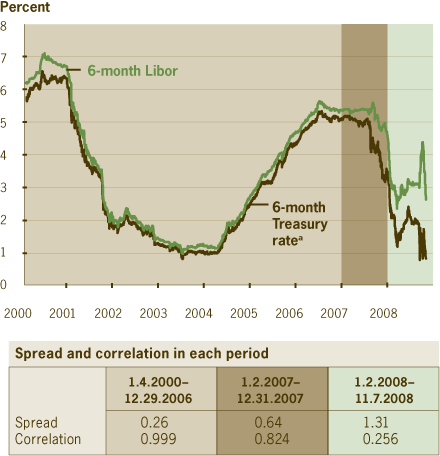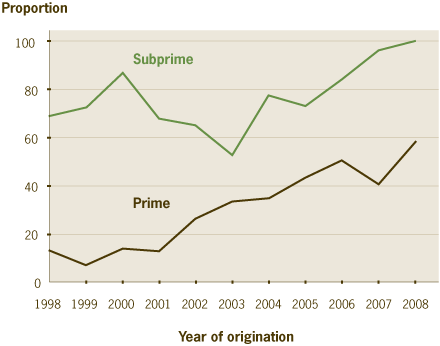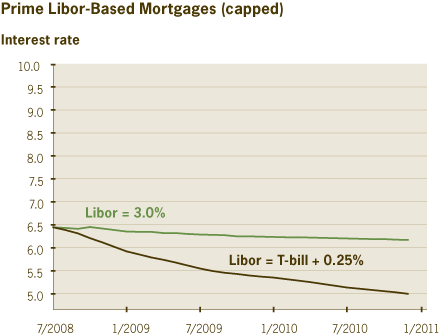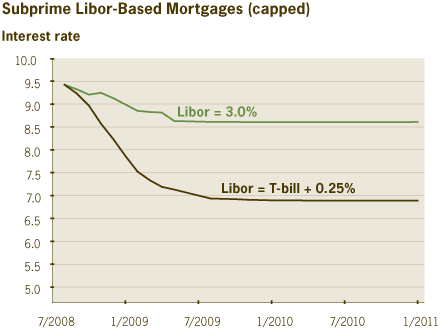- Share
Adjustable-Rate Mortgages and the Libor Surprise
Adjustable-rate mortgages have typically been tied to either of two indexes, one based on U.S. treasuries, the other on the London interbank offered rate, or Libor. The index is used to determine a mortgage’s new interest rate when it is reset, and up until recently, the choice would have made little difference. But since 2007, the rates on which the indexes are based have diverged sharply, and borrowers with Libor-based adjustable-rate mortgages are likely to pay more than they would have had their mortgages been tied to treasuries. Moreover, the proportion of Libor-based ARMs has increased significantly, especially for subprime loans.
The views authors express in Economic Commentary are theirs and not necessarily those of the Federal Reserve Bank of Cleveland or the Board of Governors of the Federal Reserve System. The series editor is Tasia Hane. This paper and its data are subject to revision; please visit clevelandfed.org for updates.
Adjustable-rate mortgages have typically been tied to either of two indexes, one based on U.S. treasuries, the other on the London interbank offered rate, or Libor. The index is used to determine a mortgage’s new interest rate when it is reset, and up until recently, the choice would have made little difference. But since 2007, the rates on which the indexes are based have diverged sharply, and borrowers with Libor-based adjustable-rate mortgages are likely to pay more than they would have had their mortgages been tied to treasuries. Moreover, the proportion of Libor-based ARMs has increased significantly, especially for subprime loans.
Changes in an adjustable-rate mortgage’s (ARM) interest rate result primarily from changes in the index rate on which it is based. The choice of index rate can vary from lender to lender, but prior to the recent turbulence in financial markets, the particular index used mattered little. That’s because the indexes, themselves interest rates of similar maturities and risk-profiles, tended to move together.
But as the financial crisis has continued, this relationship has weakened. As a result, the index on which an ARM is based, something which might have seemed as inconsequential to a borrower as the typeface used on his mortgage contract, could now mean a much higher monthly payment for some. In particular, borrowers whose mortgages are based on an interest rate known as Libor might face a higher interest rate than the comparable borrower whose mortgage is tied to the other frequently used index, which is based on U.S. Treasury rates. In this Commentary, we examine what recent financial market events might mean for borrowers with Libor-based mortgages.
Libor and Treasury Rates
The London interbank offered rate, or Libor, is an average of the interest rates on uncollateralized loans made between banks in London for some term, ranging from overnight to one year. It is determined by the British Bankers’ Association, which each day polls its panel of banks on their respective borrowing costs. The rate has served as a baseline for many bank-to-bank transactions in U.S. dollars since its establishment in 1986. It has also increasingly become the basis for many financial transactions not occurring between banks, including residential mortgages. According to the British Bankers’ Association, the various maturities of Libor that are quoted for U.S. dollar-based borrowing collectively serve as indexes, or base rates, on approximately $150 trillion of outstanding financial contracts.
In normal times, markets keep the interest rates for instruments of similar maturities and risks very comparable. Between 2000 and 2006, for instance, Libor quotes for borrowing on terms of up to one year closely followed the rates on comparable-maturity U.S. government securities, as has historically been the case. During this time, in fact, the six-month Libor was almost perfectly correlated with the six-month U.S. Treasury bill rate, with only a slight differential (0.25 percentage point on average) separating the two (see figure 1).
Figure 1. Six-Month Libor and Treasury Rates

a. Constant maturity series.
Sources: British Bankers’ Association; “Selected Interest Rates,” Statistical Release H.15., Federal Reserve Board.
Index Rates for Adjustable-Rate Mortgages
The interest rate on an ARM is determined primarily by two components: its index rate and margin. An index rate is simply another interest rate, which is typically thought to be a good proxy for a lender’s borrowing costs. It is the part of an ARM’s interest rate that adjusts. The margin, by contrast, does not change over the term of the loan. It is expressed in percentage points and added to the index rate to determine an ARM’s interest rate at its periodic adjustment points. Larger margins are associated with higher-risk borrowers, as compensation to the lender for these borrowers’ increased likelihood of default. For instance, in the subprime market, a standard ARM might use the six-month Libor as its index and add a 6 percentage point margin.
In recent years, a commonly used formulation for an ARM—known as a hybrid ARM—calls for the interest rate to be reset after an initial period, frequently two or three years, during which time the rate is fixed. For any ARM, resets generally occur monthly, semi-annually, or annually. In some cases, the extent to which an ARM’s interest rate can change during a reset is limited, or capped, and there also may be limits on the amount a mortgage’s rate can change from its initial rate.
While any rate can serve as an index, two are most often used: Libor and Treasury rates. Data from a sample of Ohio borrowers show that subprime mortgages have been based on Libor far more often than prime mortgages. According to this sample, before 2005 about two-thirds of the subprime ARMs originated in any year in Ohio were linked to Libor, with most of the remaining loans linked to Treasury rates. By 2007, nearly all subprime ARMs were linked to Libor. For prime loans, Libor was much less commonly used until recently. In 2000, fewer than one in five prime ARMs were indexed to the rate, but by 2008, the ratio was roughly one of every two (see figure 2). The data cannot reveal the cause of this shift in index rates, but the shift has become significant.
Figure 2. Proportion of Libor-Based ARMs in Ohio, July 2008

Sources: McDash Analytics; authors’ calculations.
As troubles have spread from mortgage markets into the interbank market, the difference between Treasury rates and Libor has risen to unprecedented levels. The divergence began in August 2007, as serious concerns about mortgage-backed assets began to emerge. At this point, the differential between six-month Libor and Treasury rates rose sharply to above 1 percentage point. By December, the differential had risen as high as almost 1.8 percentage points. There was some narrowing thereafter, but the differential remained high—about 1 percentage point—through the first eight months of 2008. The correlation between Libor and Treasury rates of various maturities also weakened substantially. In mid-September 2008, as several major U.S. financial entities faced collapse, Libor and Treasury rates diverged further, and by early October, the differential between the six-month Libor and Treasury rates had grown to exceed 3.5 percentage points. This is a long way from the roughly quarter-percentage point difference seen between 2000 and 2006.
As banks have become increasingly unwilling to lend to one another, concerned about the ability of their typically reliable fellow banks to repay their loans, Libor rates have risen sharply. Meanwhile, Treasury rates have fallen sharply, further widening the deviation between same-maturity Libor and Treasury rates. Depressed Treasury rates reflect a “flight-to-quality,” in which businesses and banks have sought out the least risky and most liquid securities in the marketplace. This has driven up the prices of existing Treasury securities, lowering their effective yields. Indeed, the demand for safe, liquid assets has been so great that at times market participants have pushed the yield on some Treasury securities close to zero.
Despite interventions by U.S. and U.K. authorities to improve the functioning of credit markets—including U.K. government guarantees on lending between its banks—the difference between six-month Libor and Treasury rates has remained close to 2 percentage points. As a consequence, many mortgages based on Libor are at risk of resetting to higher rates than mortgages for comparable borrowers based on Treasury rates.
The Potential Impact of an Elevated Libor
How big an impact is this circumstance likely to have on borrowers with Libor-based mortgages? To answer that question, we looked at over 72,500 existing (as of July 2008), first-lien, non-option ARMs in Ohio. Slightly more than half of these loans are linked to Libor, with the remainder linked to Treasury rates. However, Libor is a much more typical index for subprime mortgages: About 90 percent of subprime loans are linked to Libor, versus only about 45 percent of prime mortgages.
At first, it appears that borrowers with Libor-based mortgages aren’t likely to be adversely affected by the unusual behavior of Libor. Using actual data for the six-month Libor, where available, and assuming a rate of 3.0 percent otherwise after July 2008, we see that interest rates, on average, stay roughly the same or fall for Libor-based mortgages scheduled to see their first rate reset in the second half of 2008 (see figure 3).
Figure 3. Interest Rates before and after Resets for Ohio Libor-Based ARMs
| Average | Average | Average | ||
|---|---|---|---|---|
| Proportion expected to reset | Initial interest rate | Interest rate after reset | Margin | |
| Prime | ||||
| As of 7/2008 | 28.0 | 6.7 | 7.7 | 4.0 |
| 2008:H2 | 8.3 | 6.3 | 6.6 | 3.4 |
| 2009:H1 | 8.1 | 5.5 | 5.5 | 2.5 |
| 2009:H2 | 8.0 | 5.7 | 5.4 | 2.4 |
| Subprime | ||||
| As of 7/2008 | 71.3 | 8.2 | 9.4 | 5.4 |
| 2008:H2 | 18.0 | 9.0 | 8.9 | 5.6 |
| 2009:H1 | 6.6 | 9.4 | 8.7 | 5.7 |
| 2009:H2 | 2.4 | 8.9 | 9.0 | 6.0 |
Sources: McDash Analytics; authors’ calculations.
Interestingly, interest rates for mortgages that were adjusted for the first time before July 2008 (about 30 percent of prime mortgages and 70 percent of subprime mortgages in the sample) are now about a percentage point higher than their initial rates, on average. This reflects the fact that the six-month Libor fell sharply at the end of 2007, about 2 percentage points from the beginning of December to the end of January 2008. So mortgages that reset before the end of 2007, and that aren’t scheduled to reset again for a year, have yet to see the reduction in Libor reflected in their rates.
Nevertheless, Libor’s decline since the end of 2007 has, in general, been a help to those with Libor-based mortgages. But how different would the rates on these mortgages be if they had been indexed instead to the comparable Treasury rate? To determine this, we simulate the average interest rate over time for the Libor-based loans in our sample using two different interest rate indexes: an elevated six-month Libor, which we assume as before will be 3.0 percent for the foreseeable future, and a Libor more in line with a projected six-month Treasury rate. For the latter, we apply the approximate average spread between the six-month Libor and six-month Treasury rate from 2000 to 2006 (0.25 percentage points) and assume a six-month Treasury rate of 1.0 percent, to produce an index rate of 1.25 percent. For every mortgage, we also apply any cap or floor provisions called for by the mortgage contract.
Assuming a Libor of 3.0 percent produces little change as before, generating average interest-rate reductions of about 0.5 percentage point for both prime and subprime loans by 2011 (see figure 4). By contrast, the paths produced by the alternative Treasury index rate show more significant declines. The patterns of these declines also differ somewhat by mortgage grade. Average interest rates for the prime subset of mortgages decline gradually. This reflects the fact that many mortgages in this group—more than 70 percent—had yet to see their first rate-reset by July 2008, and the fact that resets occur for a fairly stable proportion of these borrowers in every month throughout the simulation period.
Figure 4. Implied Future Interest Rates for Ohio Libor-Based ARMs

Sources: McDash Analytics; authors’ calculations.
The subprime set of mortgages, on the other hand, undergoes a much more rapid decline in its average interest rate within a short period; by the beginning of 2009, most of the 1.75 percentage-point gap in the two alternative indexes has been realized. That’s because most of the subprime loans in this sample had already experienced their initial rate-reset by July 2008, and nearly 90 percent would have done so by the end of 2008. Interestingly, in our data, caps and floors appear to affect the simulated interest-rate paths for prime and subprime loans very little.
How important are these different interest-rate paths for mortgage-holders? For a typical subprime borrower, the divergence of the two rate paths quickly translates into a monthly payment difference of about $100 for every $100,000 of remaining principal (see figure 5). For prime borrowers, the resulting difference is less dramatic, but still meaningful, rising to roughly $50 by the end of 2009. In the aggregate, these differences would cost Ohio’s Libor-based ARM-holders roughly an additional $34 million in 2009 alone, should current interest-rate trends continue, with about 55 percent of this burden being shouldered by subprime borrowers.
Figure 5. Average Monthly Payment Difference per $100,000 of Principal

Sources: McDash Analytics; authors’ calculations.
Conclusion
Ongoing turmoil in financial markets has caused two rates that typically track one another closely to diverge. The unexpected result is that some mortgage-holders will not see the interest-rate relief they otherwise might have received as Treasury rates have declined. The Federal Reserve, the U.S. government, and many foreign governments have intervened aggressively to restore the normal functioning of the interbank lending market: Central banks have been lending outside of the usual channels and other government entities have guaranteed interbank lending, among other measures.
These efforts have met with some success; however, the still-elevated spread between short-term Libor and Treasury rates suggests that there may still be some way to go, even if rates do not return to past norms. Among other benefits, efforts to close this gap by bringing Libor more in line with lower Treasury rates will help homeowners whose rates are linked to Libor.
This work by Federal Reserve Bank of Cleveland is licensed under Creative Commons Attribution-NonCommercial 4.0 International





